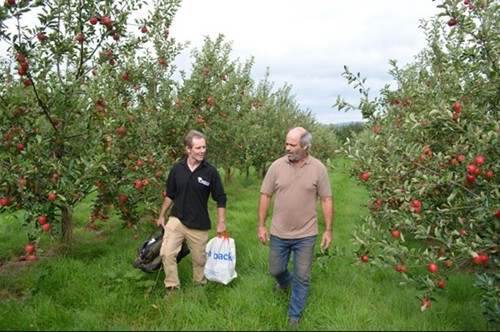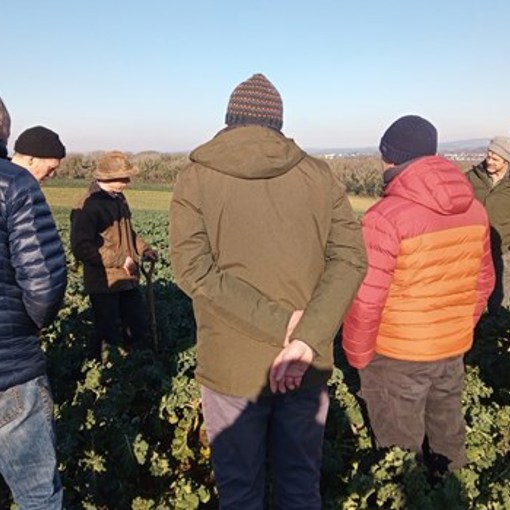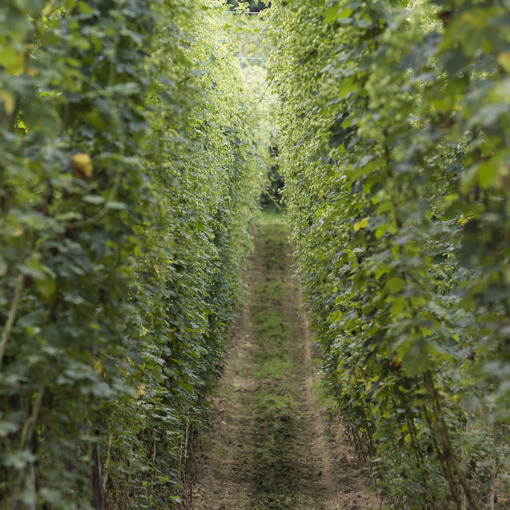In this field lab, farmers have teamed up with researchers at the University of Reading and the Bartlett Tree Research Laboratory to find out whether these results translate into the reality of a working orchard. The exciting thing about this field lab is the scale. A large range of cider producers across the country have signed up to this field lab, from multi million-pound businesses to smaller more craft focused operations.

On farm research
We joined Glynn Percival from the Bartlett Tree Research Laboratory as he visited two of the participating orchards to take measurements and find out how the research has been going for them. Glynn told us that “overall the research has been to see whether or not orchards can use woodchip made from willow trees and apply it around apple trees. We want to see if it has an influence on disease severity of apple scab. But we are also looking at whether or not it influences the quality of the apples by looking at the sugar content”.
On-farm research is important to Glynn. “It’s so easy to set your research up in a tightly controlled field environment and you get all these wonderful results. But then it has to work in the real world! And in the real world, people who are applying your techniques are not scientists, time is at a premium, everyone is just too busy. So, field labs enable us to develop a technique that works under scientific conditions but also has real applicability in the real world, dealing with real world problems”.
Visiting the trialists
First up, we visited one of the larger scale trialist’s orchards in Herefordshire. This orchard signed up to the trial alongside 8 other orchards including members of the National Association of Cider Makers. Their farm foreman told us why. “Over the years we have had more resistance showing on trees to chemicals. Added to this, consumers are wanting a more natural product. So, we’re looking at more natural ways to control fungal infections in our orchards. It’s for the future of the industry really”. He told us that 2012 was a bad year. “We had a very wet summer. It rained all the time. And we had difficulty getting the sprayers onto the wet fields. So, we had high levels of apple scab throughout the orchard”.
The orchard’s staff can see the potential benefits of a once in a season application of willow woodchip mulch already. They told us “It’s a lot cheaper than using chemicals. It would save a lot of labour time. Currently we have to spray every 14 days. On this farm it takes a day to spray. So, if it’s effective, I could probably save eight or nine days a year by using the willow woodchip.”
In this orchard they have put a total of 12 trees in the trial. The first four only had willow woodchip applied at the base. The next four had no willow woodchip applied and were not sprayed with fungicide. The final four were only sprayed with fungicide. To separate the samples two guard trees separate the three treatments.
Why farmer led research is vital
The other orchard we visited was a smaller operation run by biological farmer James Aitchison. He told us why farmer-led research like this was important “The farmers know what they need to look at. They’re the ones that are going to be growing the crops in the future so they can see the problems they will have to deal with coming up. The people in institutions don’t necessarily look at the right things for us.”
But for farmers to do their own research involves a lot of risks. James explained that “a lot of farmers can be too scared to try. The whole industry breaths fear at you. There are a lot of people making a living out of selling chemicals so they want you to carry on as usual. They do not like you sticking your neck out and growing without chemicals because you threaten a lot of incomes”.
The results from this field lab are still being collated from all the orchards across the country. But there is already energy to continue the investigations. Some of the trialists want to expand the trial next year to a bigger section of the orchard so they get more telling results.

Glynn tells us that he would like to see this go into a second year. “We now know there are other varieties out there, particularly the red willows, which have far more salicylic acid. In the future we could focus on the willow species that have even higher amounts of salicylic acid than the one trialled this year.”
But there have been some difficulties getting the research completely right. Glynn said that “There was variance in the quantity and depth of willow woodchip applied to trees. In hindsight it would have been beneficial to give more guidance to the growers such as to increase the amount depending on the size of the tree and to make sure it is always at least a minimum depth. This shows the importance of getting the trial design right at the outset to ensure that all the growers can contribute and we can get robust results.”
Get involved in your own farmer-led research
To keep informed of how this field lab and others are progressing sign up to our newsletter below.
Related news

30 January 2023
Min till and cover crops
Strip-till in horticulture: Farmers and growers collaborate to solve unanswered questions

30 June 2021
Nature friendly pest control
Farmers collaborate to find hop varieties for a growing sustainably produced beer market

14 July 2021
UK fibres